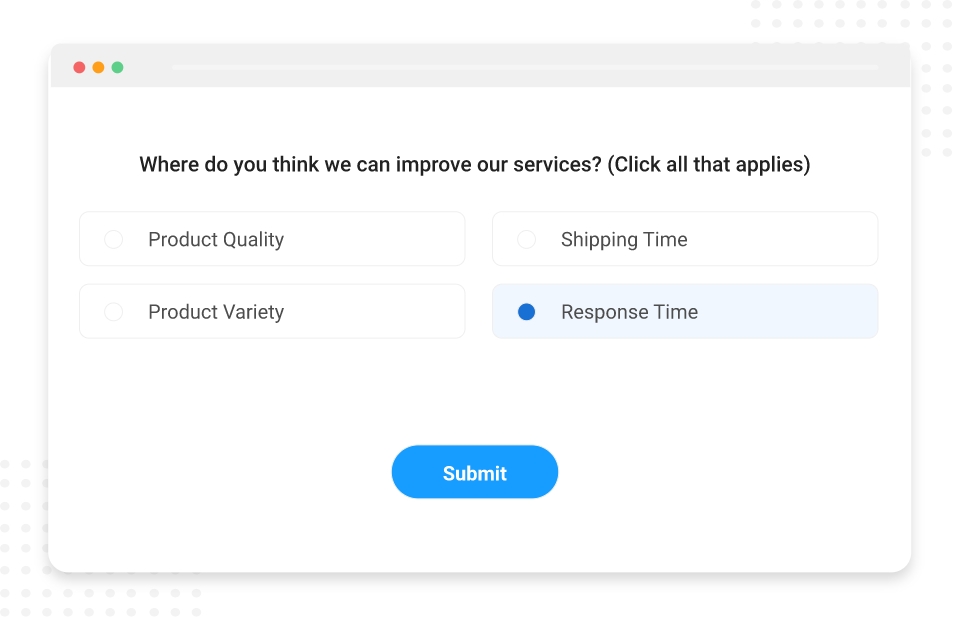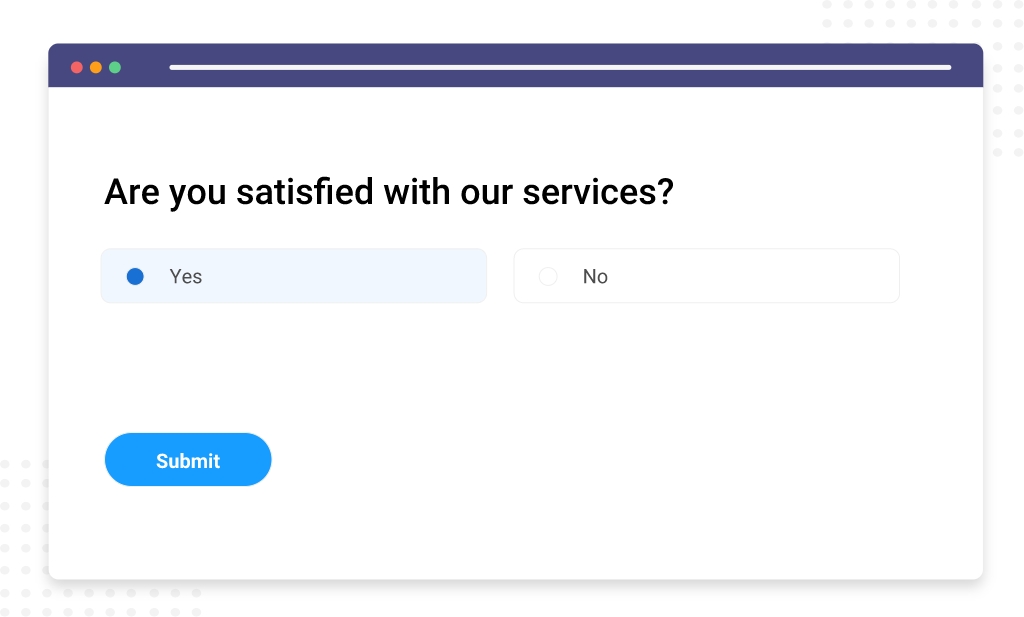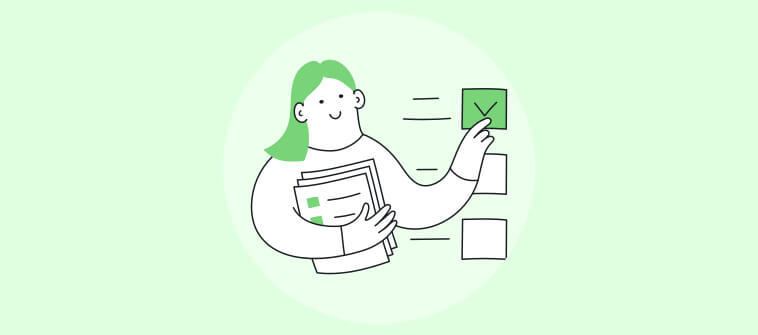
Close ended questions stand out as a powerful tool for gathering clear, concise data. They offer respondents straightforward options, making it easier to analyze and understand the collective voice of your audience. The questions in a close ended survey are direct, offering respondents a set of fixed answers. This simplicity is their strength, providing clear, quantifiable insights that are easy to analyze.
Whether you’re gauging public opinion, customer feedback, or employee engagement, close ended surveys would not only streamline the response process but also enhance the quality of data collected.
In this blog, we’ll explore how to utilize close ended questions effectively, ensuring your surveys are both engaging for participants and invaluable for your decision-making process.
But before that, here is a quick tutorial on how to create a survey with ProProfs Survey Maker:
Watch: How to Create a Survey Using ProProfs Survey Maker
What Are Close Ended Questions?
Close ended questions are structured queries that limit respondents to a set of predefined answers, such as “yes” or “no,” multiple choice, or a rating scale. These questions are designed to gather specific, quantitative data, making it easier to analyze and compare responses across a wide audience.
In a way, close ended survey questions are opposite to open ended questions, where respondents can share their thoughts and opinions in-depth.
Due to their brevity and limited response options, these questions usually generate a high survey response rate and rapidly collect large quantities of data.
Types of Close Ended Questions with Survey Examples
Close ended questions can be structured using multiple-choice options, rating scales, drop-down menus, and radio buttons. In this section, we’ll discuss the types of close ended questions along with their examples:
1. Multiple-choice Questions
Here, respondents are presented with multiple-choice answer options. It can be further divided into two types:
A. Radio-Choice
In these types of questions, respondents can only choose one answer among the given set of response options.
An example of this type of closed-ended survey question includes:
- How long have you been using our products?
☐ Less than 6 months
☐ 6 months-12 months
☐ More than 1 year
☐ More than 2 years
B. CheckBoxes
In these types of questions, respondents can choose more than one option among the given set of response options. For example,
- Where do you think we can improve our services? (Click all that applies)
☐ Product Quality
☐ Shipping Time
☐ Product variety
☐ Response Time

2. Rating-Scale Questions
Researchers use this type of question when they want respondents to rate how they feel about a particular subject, usually on a scale of 1-5.
An example of a rating-scale question for a close ended survey:
- On a scale of 1-5, how would you rate your experience with our company?

3. Ranking Order Questions
Ranking-order questions allow respondents to rank multiple-choice options based on a specific order. They ask the participants to evaluate multiple items in a particular order.
For example,
- Please rank the following according to your preference from 1 to 4, where 1 is the most necessary trait that you look for while purchasing:
☐ Quality
☐ Cleanliness
☐ Price
☐ Service speed
4. Likert-scale Questions
A Likert-scale question helps measure the participant’s opinion or attitude towards a given topic. The Likert scale is basically a five- seven- or nine-point scale used to measure the extent to which respondents agree or disagree with a particular question or statement.
A close ended survey question example for a Likert scale is:
- Do you agree with the following statement?
“I found the app easy to navigate.”
☐ Strongly Agree
☐ Agree
☐ Not sure
☐ Disagree
☐ Strongly Disagree
5. Dichotomous Questions
These are the questions that consist of two answer options. It can be “True/ False” questions, “Yes/No” questions, or “Agree/ Disagree” statements. It’s the easiest type of question for survey makers to interpret and respondents to answer.
For example,
- Are you satisfied with our services?
☐ Yes
☐ No
- Do you agree with the following statement, “It is easy to navigate your mobile app?”
☐ I agree
☐ I disagree
- The sun rises in the east.
☐ True
☐ False

60+ Examples of Close Ended Questions
Let’s discuss 60+ close ended question examples for a survey. You can use them directly or modify them as per your research.
A. Customer Feedback
- How satisfied are you with our product/service on a scale of 1 to 5?
- Would you recommend our product/service to others? (Yes/No)
- Did our product/service meet your expectations? (Yes/No)
- How likely are you to purchase from us again? (Very likely, Likely, Neutral, Unlikely, Very Unlikely)
- Have you encountered any issues with our product/service? (Yes/No)
- Did our customer service team address your concerns effectively? (Yes/No)
B. Market Research
- Which brand do you prefer for [product/service category]?
- How often do you purchase [product/service category] per month? (Once a week, Once a month, Once every few months, Rarely)
- What factors influence your purchasing decisions the most? (Price, Quality, Brand reputation, Convenience)
- On a scale of 1 to 10, how likely are you to try a new product from our brand?
- Do you prefer online shopping over in-store shopping? (Yes/No)
- Which social media platform do you use the most for product research?
C. Employee Well-being
-
- Are you satisfied with the current work-life balance? (Yes/No)
- Do you feel appreciated by your colleagues? (Yes/No)
- How often do you feel stressed at work? (Daily, Weekly, Monthly, Rarely)
- Are you satisfied with the communication within the team? (Yes/No)
- Do you have access to the resources you need to perform your job effectively? (Yes/No)
- Are you comfortable providing feedback to your manager? (Yes/No)
D. Healthcare
- Have you visited a healthcare professional in the past six months? (Yes/No)
- Are you satisfied with the quality of healthcare you receive? (Yes/No)
- How would you rate your overall health on a scale of 1 to 10?
- Do you have any chronic health conditions? (Yes/No)
- Are you satisfied with the waiting times at your healthcare provider’s office? (Yes/No)
- How often do you exercise per week? (None, Once, 2-3 times, 4-5 times, Daily)
E. Event Management
- Did you enjoy the event? (Yes/No)
- Were the event timings convenient for you? (Yes/No)
- How likely are you to attend a similar event in the future? (Very likely, Likely, Neutral, Unlikely, Very Unlikely)
- Did you find the event venue easily accessible? (Yes/No)
- Was the event well-organized? (Yes/No)
- Did the event meet your expectations? (Yes/No)
F. Education
- Are you satisfied with the quality of education provided? (Yes/No)
- How would you rate your overall learning experience on a scale of 1 to 5?
- Do you find the course material engaging and relevant? (Yes/No)
- Are the instructors knowledgeable and approachable? (Yes/No)
- Would you recommend this course to others? (Yes/No)
- Did the educational institution meet your expectations? (Yes/No)
G. Product Development
- Which feature of our product/service do you find most useful?
- How satisfied are you with the recent updates to our product/service? (Very satisfied, Satisfied, Neutral, Dissatisfied, Very dissatisfied)
- Would you be interested in participating in beta testing for new features? (Yes/No)
- Are you aware of all the features our product/service offers? (Yes/No)
H. Marketing Effectiveness
- How did you hear about our product/service? (Social media, Word of mouth, Advertisement, Search engine, Other)
- Have you engaged with our brand on social media? (Yes/No)
- Did the promotional offer influence your purchase decision? (Yes/No)
- Did the advertisement effectively communicate the benefits of our product/service? (Yes/No)
I. Work Environment
- Do you feel valued by your employer? (Yes/No)
- Are you satisfied with the office facilities? (Yes/No)
- How comfortable are you with the current seating arrangement? (Very comfortable, Comfortable, Neutral, Uncomfortable, Very uncomfortable)
- Do you feel that your skills are being utilized effectively in your current role? (Yes/No)
J. Customer Service
- How would you rate the responsiveness of our customer service team? (Excellent, Good, Average, Poor, Very poor)
- Were your inquiries resolved in a timely manner? (Yes/No)
- Did the customer service representative address your issue satisfactorily? (Yes/No)
- How often do you contact customer service for assistance? (Frequently, Occasionally, Rarely, Never)
K. Environmental Sustainability
- Are you aware of our company’s efforts toward environmental sustainability? (Yes/No)
- How important is environmental sustainability to you when choosing a product/service provider? (Very important, Important, Neutral, Not important, Not at all important)
- Would you be willing to pay a premium for eco-friendly products/services? (Yes/No)
L. Diversity and Inclusion
- Do you feel that our company promotes diversity and inclusion effectively? (Yes/No)
- Have you ever experienced discrimination or bias in the workplace? (Yes/No)
- Do you believe that your ideas and opinions are valued regardless of your background? (Yes/No)
M. Technology Usage
- How frequently do you use our mobile app? (Daily, Weekly, Monthly, Rarely, Never)
- Are you satisfied with the user interface of our website? (Yes/No)
- Have you encountered any technical issues while using our software? (Yes/No)
Want to create a close ended questionnaire with the example questions?
When to Use Close Ended Questions?
Close ended questions are used in surveys to gather specific and relevant information. Understanding when to utilize these questions is essential for collecting actionable and quantitative data.
So let’s look at the possible areas where close ended questions can be used effectively.
1. For Quantitative Analysis
Closed-ended questions are most useful when the aim is to gather numerical data. Their structured format provides easily quantifiable responses, facilitating statistical analysis. This data can be efficiently processed and presented using graphs or charts for enhanced comprehension.
2. For Segmentation Purposes
Utilizing closed-ended questions enables the segmentation of respondents based on their answers.
For instance, demographic segmentation by age groups such as “under 20,” “20 to 40,” and “over 40” allows for a targeted understanding of distinct preferences and needs within different demographic segments.
3. To Enhance Response Rates
People find it easier to answer surveys with closed-ended questions, and thus, close ended questions tend to elicit higher response rates compared to open-ended questions. Open-ended questions need long answers, which can put people off. This simplicity encourages increased engagement with the survey.
4. For Standardization and Consistency
Closed-ended questions ensure uniformity in responses across all respondents. By presenting the same set of response options to each participant, ambiguity and inconsistency are minimized. This standardization streamlines data analysis and interpretation.
5. For Efficient Data Analysis
The structured format of closed-ended questions facilitates efficient data analysis. Responses can be easily quantified, allowing for straightforward computation of statistics and metrics. This streamlined process enables researchers to derive meaningful insights and actionable conclusions.
What Are the Advantages of Using Close Ended Questions?
You do get many advantages when using closed-ended questions in a survey – hence, the popularity! However, remember that they are not suitable for all types of research; therefore, you should consider the type of data you want to collect before using them.
Let’s see some of the prime benefits of close ended questions:
- Precision: Closed-ended questions provide specific and precise responses, allowing for a clear interpretation of data.
- Ease of Analysis: Responses to closed-ended questions can be easily quantified and analyzed, streamlining data processing and interpretation.
- Standardization: By presenting the same set of response options to all respondents, closed-ended questions ensure consistency in data collection.
- Increased Response Rates: Closed-ended questions are often quicker and easier for respondents to answer compared to open-ended questions, resulting in higher participation rates.
- Segmentation: Responses to closed-ended questions facilitate the segmentation of respondents based on their answers, enabling targeted analysis and tailored strategies.
- Reduced Bias: Closed-ended questions minimize the influence of interviewer bias and respondent variability, leading to more objective data collection.
- Compatibility with Statistical Methods: Closed-ended questions yield quantifiable data that can be easily subjected to various statistical analyses, allowing for robust research findings.
Disadvantages of Closed-Ended Questions
As beneficial as they are, closed-ended questions aren’t entirely devoid of disadvantages either, such as
- Limited Insight: Closed-ended questions may constrain respondents’ ability to express nuanced or detailed opinions, resulting in potentially shallow insights.
- Inflexibility: Closed-ended questions offer limited flexibility compared to open-ended questions, making it challenging to explore unexpected or unanticipated responses.
- Difficulty in Question Design: Crafting effective closed-ended questions requires careful consideration of response options and question structure to ensure clarity and relevance, which can be time-consuming.
- Risk of Oversimplification: Closed-ended questions may oversimplify complex topics or issues, leading to incomplete or misleading data that fails to capture the full complexity of respondents’ experiences or opinions.
- Lack of Context: Without the opportunity for respondents to provide context or explanations for their answers, closed-ended questions may result in data that lacks depth and context, limiting the researcher’s understanding of the underlying factors influencing respondents’ responses.
Best Practices for Using Closed-Ended Questions
No one likes to fill out a survey that takes hours to complete. To collect data efficiently and increase the survey response rate, you need to keep your participant’s attention span in mind.
Some best practices for using closed-ended questions such that their accuracy and usefulness remain in place are given below:
1. Keep Questions Clear and Concise
- Ensure that questions are easy to understand and unambiguous.
- Use simple language and avoid jargon or technical terms that might confuse respondents.
- Keep questions brief and to the point to maintain respondent engagement.
For example, instead of asking, “Do you like our product?” that is too vague and lacks specificity, try asking, “How satisfied are you with the ( ______) of our product?”.
This question is clear and specific, focusing on a particular aspect of the product to provide clearer responses.
2. Use Proper Question Structure
- Frame questions in a way that allows for straightforward responses.
- Avoid double-barreled questions that address more than one issue, as they can lead to confusion and inaccurate responses.
- Use a single question to address each specific aspect of the topic being explored.
See this question: “Do you prefer online or in-store shopping, and why?”. Pretty confusing, right? This question combines two topics (shopping preference and reasons) into one, making it difficult for respondents to provide coherent answers.
Instead, you can ask, “Do you prefer to shop online or in-store for groceries?”
This question addresses a single issue (shopping preference) without combining multiple topics, ensuring a clear answer.
3. Provide Balanced Response Options
- Offer a balanced set of response options that cover the full range of possible answers.
- Include a “Neutral” or “Not Applicable” option when relevant to allow respondents to express uncertainty or indicate that the question does not apply to them.
- Avoid leading or biased response options that may influence respondents’ answers.
A question framed like, “Don’t you agree that our product is the best on the market?” presumes a positive response and may influence respondents to agree even if they have a different opinion. This is a marked example of a leading or biased question.
A neutral question allows respondents to provide their opinions without being influenced by biased language. An example being, “How would you rate the quality of our product compared to other options available on the market?”
4. Use Likert Scales Appropriately
- Utilize Likert scales (e.g., strongly agree, agree, neutral, disagree, strongly disagree) for questions requiring nuanced responses or measurement of attitudes and opinions.
- Ensure that the scale is balanced and includes an equal number of positive and negative response options.
- Provide clear anchors for each point on the scale to guide respondents in their selection.
5. Randomize Response Order
- Randomize the order of response options to minimize order bias, where respondents may be more likely to select options presented earlier or later in the list.
- This ensures that the distribution of responses is not influenced by the order in which options are presented.
6. Pilot Test Questions
- Before deploying a survey or using closed-ended questions in research, conduct a pilot test with a small sample of respondents to identify any issues with question clarity, response options, or survey flow.
- Use feedback from the pilot test to refine questions and improve the overall quality of the survey instrument.
7. Combine Closed-ended and Open-ended Questions
- Supplement closed-ended questions with open-ended questions to allow respondents to provide additional context or elaborate on their responses.
- This combination of question types provides a more comprehensive understanding of respondents’ perspectives and experiences.
For example, “How satisfied are you with our product? Please explain the reasons behind your satisfaction or dissatisfaction.”
This combination allows respondents to provide additional context or detail beyond the closed-ended response.
8. Analyze Data Thoughtfully
- Once data collection is complete, analyze closed-ended responses carefully, considering the distribution of responses, patterns, and trends.
- Compare responses across different demographic groups or segments to identify variations in attitudes or behaviors.
- Interpret results in the context of the research objectives and any limitations associated with the data collection process.
9. Use Closed-ended Questions in Moderation
- While closed-ended questions offer efficiency and ease of analysis, they may not capture the full complexity of respondents’ experiences or perspectives.
- Use closed-ended questions judiciously and complement them with other research methods, such as interviews or observation, to gain a deeper understanding of the topic.
Use Close Ended Questions Smartly to Gather Quantifiable Insights
We have almost reached the end of this blog and have seen that close ended surveys offer valuable insights when utilized effectively. They provide precise data, ease of analysis, and standardized responses, making them indispensable tools for researchers and organizations alike.
However, it’s essential to acknowledge their limitations, including potential response bias and limited insight. By leveraging the advantages of closed-ended surveys while remaining mindful of their drawbacks, you can enhance the quality of their data collection efforts.
Whether conducting market research, gathering customer feedback, or evaluating employee satisfaction, understanding when and how to employ closed-ended surveys is essential for obtaining actionable insights.
To start gathering in-depth insights in no time, use our free inbuilt survey templates here!
FREE. All Features. FOREVER!
Try our Forever FREE account with all premium features!








